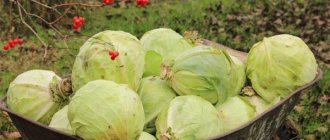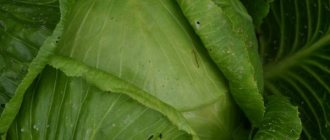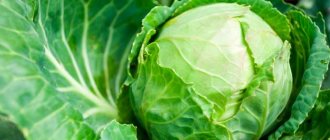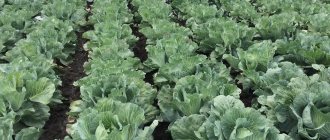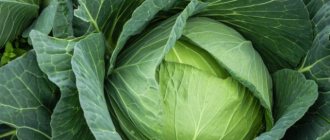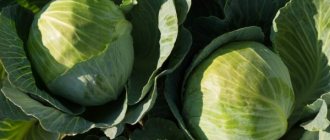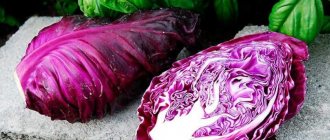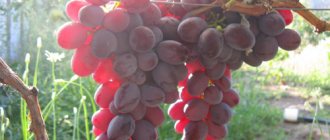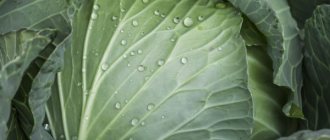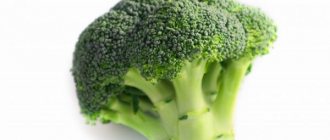Vegetable growing » Cabbage
0
1152
Article rating
Kira Stoletova
Yubileiny cabbage is recommended for planting in household plots, garden plots and small farms. It is unpretentious in agricultural technology compared to other crops.
Features of Yubileiny cabbage
Description of the Yubileiny cabbage variety
The originator is agro. The main goal when breeding the Yubileiny F1 cabbage variety was to obtain a hybrid that has a relatively short ripening period and at the same time can be stored for a long time. Overall, the originator coped with the task. The ripening period for Yubileiny cabbage ranges from 90 to 100 days. It can be stored for 5-6 months.
The number of outer leaves of the Yubileiny variety rarely exceeds 5-6 pieces
Externally, it is an ordinary white cabbage, having a round or slightly flattened shape and a white-green color. The leaf blades are slightly oblong, with a strong seal at the base. The diameter of the heads is about 22 cm. The weight of ripened cabbage is from 1.5 to 2 kg.
Attention! In some cases, the outer leaves of the Yubileinaya variety have a slightly corrugated structure.
How to properly plant cabbage seedlings
Late varieties of cabbage are best grown in seedlings, especially in regions with a short warm period, where the heads of cabbage may not have time to ripen before the onset of frost. It is planted in a permanent place when the seedlings are 30-35 days old.
Planting cabbage seedlings later - video
Seeds collected independently from the garden are processed as follows:
- in hot water – 1/3 hour;
- cold – 1 minute;
- 12 hours – in a solution with microelements;
- 24 hours - in the refrigerator.
The composition of such soil should be as follows:
- 1 part river sand;
- 1 part garden soil;
- 1 part peat (or humus).
WHITE CABBAGE!
• Krautman white cabbage F1• Atria cabbage F1• JUNE cabbage
It is better to plant late cabbage seeds in separate containers so as not to injure young seedlings during the picking procedure.
Advantages and disadvantages
The positive properties of the hybrid include:
- relatively short ripening periods;
- storage duration up to six months;
- excellent taste raw and fermented;
- high resistance to almost all diseases;
Negative properties are:
- deterioration of taste during heat treatment.
Jubilee cabbage is a typical representative of salad vegetables. It is practically not used for preparing hot dishes and baking.
Which variety is better to choose for pickling and pickling?
Mostly late varieties are ideal for fermentation. True, you can use a mid-season crop for pickling. Cabbage recommended for pickling ripens within 120-150 days. It should have a dense, uncracked head and a sweetish taste.
Slava 1305
This is the most ideal variety for pickling. It can be grown in any region. True, heads of cabbage are not stored for a long time (only until January). Seedlings at a young age are susceptible to diseases (black leg). Heads of cabbage often crack when ripe. It is advisable to harvest after the first frost. The heads of cabbage become sweeter and are not bitter. The average weight of vegetables is 3-5 kilograms. Ripe heads of cabbage have a pleasant greenish color. There are white leaves inside.
Belarusian
A crop developed in 1937 that is resistant to frost and many diseases. Vegetables can be grown in northern latitudes. It is better to harvest after the first frost. Late-harvested cabbage is sweeter and less bitter. Ripe vegetables are plump and pale green in color. The weight of one is about 3-4 kilograms. The heads do not crack during growth and tolerate drought well. Sauerkraut is very tasty when sauerkraut. It can be stored raw, but not more than 3 months.
Present
Cabbage ripens in late August and early September. The medium-sized leaf rosette is slightly raised. Ripe vegetables are plump, round, greenish-white in cross section. The weight of one vegetable is 2.5-4.5 kilograms. Cabbage can be stored in a cool room until March. Vegetables are suitable for pickling and preparing fresh vegetable salads.
Valentina F1
Hybrid late culture. The plant has a raised rosette and medium-sized leaves. A ripe vegetable is round, plump, and white in cross section. The weight of one is 3-4 kilograms. Harvested cabbage can be stored for 7 months. The heads are juicy and sweet. An ideal variety for pickling. Does not crack, rarely gets sick, does not rot.
Planting and caring for Yubileiny cabbage
It is recommended to grow Yubileiny cabbage in open ground. When planting seeds in mid-April, the harvest will be obtained in the second ten days of July. If earlier cultivation is required, use the seedling method.
In this case, the seeds are planted in boxes in early March. The seeding material is buried 1 cm. As soon as the seedlings appear, the boxes with seedlings are placed in a bright place with a low temperature (from + 5 ° C to + 8 ° C). Planting in open ground is carried out 35-40 days after the seed hatches. Planting pattern – 60x50 cm or 60x70 cm.
Planting in open ground occurs when the hybrid has three or more leaves.
Caring for Yubileiny cabbage consists of watering and fertilizing. Soil treatment is also required in the form of loosening and hilling as necessary. Watering is carried out at intervals of several days, while focusing on the moisture content of the top layer of soil. Recommended norms are up to 20-30 liters per 1 sq. m.
Fertilizing is done three times per season. The first is carried out in early May. In this case, organic fertilizers are used in the form of a solution of mullein or chicken droppings. The second is performed about a month later, using the same composition. The third feeding is mineral (phosphorus-potassium mixture in standard concentration for cabbage, no more than 50 g per 1 sq. m). It is applied 1-2 weeks before the expected harvest date.
Important! The indicated application times are for crops planted in open ground. When grown by seedlings, they are carried out 1-1.5 months earlier.
Harvest and storage
Rinda is characterized by the uniform ripening of heads of cabbage, which allows harvesting at the same time. This is convenient for both transportation and processing.
Collection is carried out manually or by mechanized means.
How and when to collect
The readiness of heads of cabbage for cutting is checked in the second half of August. The time for collection comes when the heads become dense and hard to the touch. There is no need to rush into harvesting too much: the heads of cabbage variety Rinda are resistant to cracking and stand well on the stems. Tolerant to transportation even when fully ripe.
It is better to collect in dry, cool weather. The heads of cabbage are cut with a knife, leaving the lower leaves and part of the stem 3-4 cm long.
Storage features and shelf life of the hybrid
According to the originator, it is advisable to store fresh cabbage for no longer than 4 months. There are mentions that if storage conditions are met, the shelf life of heads of cabbage can reach 6 months without a noticeable drop in quality.
The storage temperature for cabbage is no higher than +5...+6°C, optimally - from -1 to 2°C.
It is better to lay the heads of cabbage on a wooden floor, placing the stalks up, or on straw.
At home, it can be stored in the refrigerator, on the lower shelves, wrapped in parchment paper.
Diseases and pests
The most common disease affecting the hybrid is clubroot. External manifestations include wilting of the leaves and subsequent death of the plant.
The cause of the disease is a fungus that leads to the appearance of growths on the rhizome
There is no treatment; affected specimens must be dug up and destroyed off-site. Preventive measures to combat the disease include pre-planting soil treatment with slaked lime (up to 500 g per 1 sq. m) and other methods of reducing its acidity. Clubroot does not appear on alkaline soils.
The main pest of the Yubileinaya variety is the cabbage moth. Considering the timing of ripening, the plant can be affected by the first and second generations of the insect.
Cabbage moth larvae make large holes in the leaves of the Yubileiny variety.
Pest control is carried out using chemical and biological agents. An effective remedy against moths will be the insecticides Butizan or Decis. The bacteriological drugs Bitoxbacilin and Dendrobacilin have also proven themselves well.
Characteristics of land for cabbage
Cabbage cannot live in the cold. She loves the warm rays of the sun, which provide her with bright light, so the place for seeding beds should be in a lighted area. Every year the place for sowing seedlings in the ground needs to be changed. If beets, onions, cucumbers, and military crops were previously cultivated on the site, then great.
You cannot sow cabbage after cruciferous vegetables. After 5 years, the soil will be suitable for re-sowing sprouts. If this rule is not followed, then diseases accumulate in the soil, and the cabbage family begins to get sick.
Use of cabbage on the farm
This vegetable has long been widely used in folk medicine. What do you think was the purpose of Pythagoras growing it? I tried the beneficial effects of cabbage leaves on myself when I gave birth to my eldest son. I had a lot of milk for feeding, and sometimes it stagnated.
Sauerkraut juice, for example, helps restore the body after a long period of cold weather. It saturates the body with vitamin C and, thus, is a natural prevention of spring vitamin deficiency. Liquid extracted from fresh cabbage leaves has wound-healing properties, cleanses the body of toxins, relieves colds, and reduces joint pain.
Face masks with the addition of cabbage are widely used in folk cosmetology. It saturates the skin with nutrients, whitens it, smoothes wrinkles, and improves tone. And this natural remedy gives smoothness and dazzling shine to your hair.
Very often these vegetables, or more precisely, the waste from them in the form of leaves, are used to feed livestock. Such food is cheap for people and nutritious for animals.
White cabbage, by the way, can be not only tasty and healthy, but also beautiful. Caring Japanese breeders have developed a number of ornamental varieties of this plant. So, for example, its headless garden variety is a rosette, in which the outer leaves are painted green, and the inner leaves, tightly adjacent to each other, are bright and pale pink, lilac, purple
If you plant this variety in a flowerbed, in the fall you will get huge flowers that attract attention and are pleasing to the eye.
How to grow cabbage at home?
Cabbage can be grown in a city apartment
To do this, it is important to prepare the soil, consisting of a mixture of turf soil (or peat), ash and humus
The prepared seed should be pre-stratified, that is, treated with cold to increase its viability, disinfected and germinate. Before sowing, the soil is moistened, and the first shoots are thinned out and planted (transplanted from a smaller container to a larger one).
If you don’t know how to care for this plant, just remember one simple saying: “Cabbage loves water and good weather!” Try to provide your seedlings with enough light from the window and a fluorescent lamp, do not allow the soil to dry out, and also provide the young leaves with warm air, the temperature of which ranges from +18 to +20 °C. And then cute round heads of cabbage will settle in your house.
Back to contents
Cabbage is not for food, but for pleasure
A few words should be said about Brussels sprouts. First of all, a significant drawback of this valuable crop is that the growing season is too long.
This was the first thing I noticed, but my hand still reached out to the bag of seeds, and the planting was carried out. In the first year, this type of cabbage showed itself in all its glory: an average of 15 full-fledged dense heads the size of a walnut were collected from each bush (photo 5)
It was decided to leave the rest, shrinking towards the top, until spring. Harvesting was carried out already in mid-November with sufficiently high snow cover, and planting was carried out in early May.
Based on many years of observations, I can say that Brussels sprouts do not tolerate competition and need moderate watering and a warm, sunny place. It is definitely not suitable as a sealant or marker crop. To plant it, you need to take care of the place in advance, including from the aesthetic side, because it is an active garden dominant that attracts the admiring glances of neighbors and friends. If you don’t get a chance to taste the wonderful heads of cabbage, at least you will please yourself and those around you with a crop that is still exotic for domestic gardens.
The best mid-season varieties
Mid-season varieties require a longer period for ripening - from 130 to 145 days. These varieties, unlike early ripening ones, contain more sugar and vitamin C. They are suitable for short-term storage and are suitable for pickling, pickling and other pickles.
Rinda
Hybrid from Dutch breeders. Experts recommend growing it in the Central and Volga-Vyatka regions of Russia, but gardeners in Siberia and the North-Western region also cultivate it without any tricks.
The fork is round, very dense, weighing from 3.2 to 3.7 kg, prone to cracking. When cut, it has a yellow-white color. The leaves are thin, elastic, light green. The stalk is short.
Rinda has high yields, tolerates temperature changes, is immune to various diseases, but suffers from attacks by pests - white butterflies, cruciferous flea beetles and slugs. However, this hybrid does not tolerate prolonged droughts and needs plenty of sunlight.
Tobia
Another Dutch hybrid, which is intended for cultivation in most regions of Russia, with the exception of the Northern, Central Black Earth, North Caucasus, Lower Volga and Far Eastern regions. The head of cabbage has a round shape and weighs a maximum of 3 kg.
The leaves are gray-green with a waxy coating of medium intensity. They are thin, without coarse veins. The cutout of the forks is painted white. When overripe, it does not crack. Cabbage is immune to Fusarium wilt. If overwatered, the lower leaves may rot. Cabbage can be stored for no more than 3 months.
Slava 1305
Soviet variety, bred in 1938. It can be grown in all regions of the Russian Federation. The head is round or round-flat, medium or large in size, dense. Weight can reach up to 7.9 kg, minimum - 2 kg.
The leaves are medium-sized, finely wrinkled, round, grayish-green or green, covered with a weak or medium layer of waxy coating. There is no point in delaying harvesting, as cabbage is prone to cracking. The variety is not resistant to clubroot, Fusarium wilt and vascular bacteriosis.
Present
Another Soviet variety, which still does not lose popularity among gardeners and is intended for cultivation throughout Russia. The variety is characterized by high yield, seedling resistance to frost and is suitable for long-term storage (up to 5 months).
The head of cabbage is resistant to cracking. The fork is rounded or rounded-flat, very dense with an average weight of 3.5 kg. The leaves are wrinkled, gray-green in color with a strong or medium waxy coating. The edges are slightly wavy.
Belorusskaya 455
This cabbage is considered one of the best for pickling and is cultivated in all regions of the Russian Federation, with the exception of the North Caucasus and Lower Volga districts. This is a moisture-loving, cold-resistant variety that prefers to grow only on fertile soils and is demanding on soil moisture.
The head of cabbage is round, very dense, weighing up to 4 kg, and is not prone to cracking. The leaves are slightly wrinkled or smooth, and the color varies from gray-green to dark green. The stalk is short. The variety is not immune to clubroot and vascular bacteriosis.
Menza F1
A Dutch hybrid that is drought-resistant and high-yielding. The round-flat head of cabbage is very dense, colored white in cross-section, weighing from 4 to 9 kg, and resistant to cracking. The leaves are gray-green and completely covered with a waxy layer.
The hybrid is grown in almost all regions of Russia. Its advantage is its resistance to powdery mildew, tobacco mosaic and bacteriosis, however, it does not have immunity to clubroot. Cabbage can also suffer greatly from pests - cabbage flea beetles and aphids.
Aggressor
A Dutch hybrid that has taken root throughout Russia, with the exception of the Arkhangelsk and Murmansk regions and the Republics of Karelia and Komi. The head is dense, medium in size and round in shape. In cross section it has a yellow-white color.
The leaves are green with a strong waxy coating. They are round, slightly bubbly, and slightly wavy along the edge. The plant is resistant to fusarium and is not damaged by cruciferous flea beetles and thrips, thanks to its rough leaves. The greatest danger to “Aggressor” is represented by whiteflies and aphids; the plant is affected by diseases of fungal origin.
Cabbage tolerates unfavorable weather conditions, lack of nitrogen in the soil, and can grow on depleted soils. When salting, bitterness may appear.

